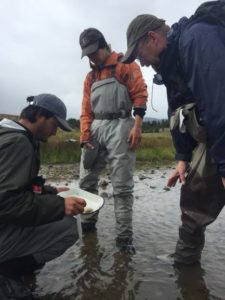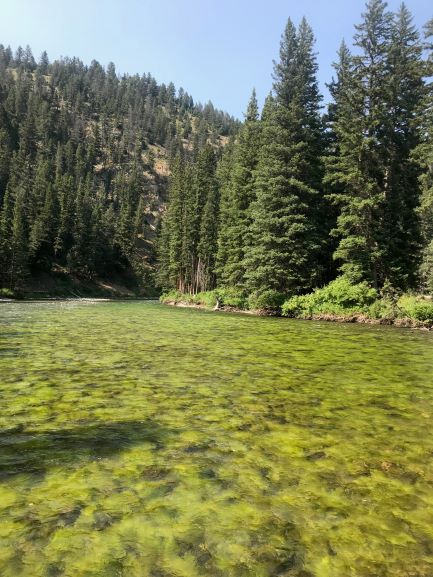By Jessianne Wright EBS Contributor
BIG SKY – An unprecedented algae bloom appeared over large reaches of the Gallatin River and its tributaries in late July and continues to persist. While the bright green algae, which is filamentous and not a cyanobacterial species, is not harmful to humans, its presence has caused alarm in some conservation and recreation circles. The exact cause of the bloom is currently under investigation by area organizations.
Kristi Ponozzo, the public policy director for the Montana Department of Environmental Quality, told EBS in an email that the agency’s resources are focused on other blooms that do pose a threat to humans and wildlife, and the agency is not able to comment on the cause of the Gallatin algae.
The bloom has been confirmed in new-growth and die-off phases in the Gallatin River from the West Fork confluence to Moose Creek, and in the South Fork of the West Fork, the West Fork, Taylor Fork and Wapiti Creek, all of which flow into the Gallatin. In early August, a bloom was also documented on the Gallatin River from Williams Bridge north of Gallatin Canyon to Axtell Bridge north of Gallatin Gateway.
“What’s so unique about the 2018 Gallatin algal bloom is the intensity and breadth, as well as the location,” said Guy Alsentzer, executive director of Upper Missouri Waterkeeper, a Bozeman nonprofit that is currently studying the Big Sky-area bloom through water samples and visual observation.
Alsentzer added that the algae itself is not a concern and it does occur naturally, but when it covers such large areas of a waterway, it can start to change the river habitat and impact insect and fish populations.
“It could be a whole slew of different causes,” said Gallatin River Task Force Executive Director Kristin Gardner, whose organization is also collecting samples on the river. Gardner declined to elaborate prior to viewing the study results, which will be compared with historic data the Task Force has collected over the past 10 years.
Gardner added that on the West Fork, some nitrogen samples have exceeded state standards, “but not by much.” Historically, she said, no nitrogen samples from the mainstem have exceeded state standards.
“Until we get the data, we can’t really say what’s going on. Data results will tell what is the cause and what it means,” said Jack Murray, an intern for the Gallatin River Task Force who oversees the sampling field work. He added that stream flow, temperature and sunlight are factors that contribute to a bloom.

Algae samples for Gallatin River Task Force’s study were taken throughout September at seven sites on the mainstem of the Gallatin, 11 in the West Fork, and three in Taylor Fork.
Upper Missouri Waterkeeper is testing water quality at six locations in the Big Sky area, including locations on the West Fork, as well as both upstream of the canyon area and downstream of the confluence with the West Fork on the Gallatin mainstem.
While this organization is also awaiting results, Alsentzer and his staff have been documenting visual observations with underwater cameras and drones. Alsentzer said this work indicates the algae is growing downstream of locations that likely contribute to high nutrient-loading, such as development sites, septic drain fields and effluent surface applications. Gallatin River Task Force agrees that these sites could be potential sources for the pollution.
“We find the distinct locations of algal blooms on the Gallatin and tributaries very compelling because each event speaks to likely potential sources of nutrient pollution.”
Nutrient-loading refers to the process when too many nutrients—most commonly nitrogen and phosphorus from urban runoff or effluent—are added to bodies of water. Similar to the effects of fertilizer, this high level of nutrients can feed the excessive growth of algae.
“This algal bloom is a very vivid reminder that it’s time to act and proact,” Alsentzer said. “This is the tipping point to make decisions so it doesn’t get worse.”
In response to the algae bloom, Big Sky Water and Sewer District general manager Ron Edwards described this year’s very high runoff after a snowpack that was 150 percent of average. “That could be a part of it,” he said. “We’re already looking at updates that will significantly improve our treatment plants, especially in the winter months.”
Currently, the Big Sky Water and Sewer District is evaluating two different wastewater treatment upgrades as a result of increasing capacity and outdated technologies. Bozeman’s Advanced Engineering and Environmental Services have been contracted to conduct this evaluation and a final report is scheduled for the end of September.
According to information provided by Advanced Engineering and Environmental Services on behalf of the district, the two upgrade systems under consideration are the AquaNereda aerobic granular sludge and membrane bioreactors systems, both of which would enable the treatment facility to achieve lower nutrient concentrations.
As of EBS press time on Sept. 12, Alsentzer said that despite cooling temperatures and increasing precipitation, the algae continues to develop through a life-cycle where decaying algae releases nutrients and oxygen that fuels the growth of new blooms. Both Upper Missouri Waterkeeper and Gallatin River Task Force anticipate test results from their studies later this fall, which might ultimately shed light on the initial cause of the bloom.












